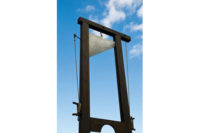The cone silence. Perhaps you’ve heard about it. Since the Trump administration took over on January 20, very little news has come out of OSHA. This is no surprise, given the circumstances. Check out the agency’s org chart on its website. At press time, the assistant secretary (the head honcho) position is vacant. The chief of staff is vacant. Senior advisors are vacant. One of two deputy assistant secretaries is vacant. The other is occupied by agency careerist Dorothy Dougherty, who is minding the store and near retirement, one source tells ISHN.
She is being assisted by Tom Galassi, director of enforcement programs, another careerist, according to this source. Their charge from the administration is to keep the ship steady, no new initiatives or anything like that, according to the source, with close ties to the agency. Normally, long before this time, OSHA would have a politically-appointed deputy on board, such as Jordan Barab with the Obama administration in 2009, according to this source.
Not for the first time
So, not for the first time in OSHA’s 46-year history, the agency is rudderless. No direction. No policy announcements. Silence. No news is good news — not a problem — for some members of the business community. Not so much for organized labor. And for ex-OSHA chief Dr. David Michaels and Mr. Barab. Both have complained publicly about the lack of OSHA press releases on enforcement cases. At press time, since January 20, inauguration day, the national OSHA press office in DC has issued seven press releases total. Only one, a whistleblower case, regards enforcement. The rest are soft news: a “Safe & Sound Week” announcement; a fall prevention National Stand Down week announcement; etc.
Since January 20, OSHA’s regional offices have been a tad more active in publicizing enforcement cases, issuing at press time seven press releases relating to enforcement cases.
In contrast, from January 1 to January 19 of this year, the outgoing Obama OSHA issued 18 enforcement press releases, all from regional offices. In the month of December, 2016, agency offices issued 24 enforcement-related press releases, almost one a day.
In the immediate aftermath of the last transfer of power between opposing parties, from January 21, 2009 to January 30, the incoming Obama administration issued eight enforcement press releases, again, almost one per day. In February of that year, 16 enforcement press releases were issued; in March, 20; in April, 17.
The pendulum swings
This change in approach about publicizing enforcement cases is only natural, you could argue. OSHA is transitioning from an enforcement-friendly Democratic administration to a more pro-business Republican regime. But in January, 2006, during the George W. Bush administration, OSHA issued 14 enforcement press releases. In one release, then Labor Secretary Elaine Chao stated, “Worker safety should be a top priority for every employer. The department will take serious actions to protect workers’ health and safety at the workplace.”
So why the debate now over OSHA’s shaming and blaming of employers through news releases? The practice has been going on in both Republican and Democratic administrations for years if not decades.
Dr. Michaels recently said shaming may be the most effective means for OSHA to encourage elimination of life-threatening hazards.
“The press releases are a statement of fact and the large citations are news-worthy events,” says Jim Frederick, safety official with the United Steelworkers Union.
“My personal belief is that ‘naming and shaming’ does not change corporate behavior. It only puts more money into the pockets of attorneys and marketing experts,” says a long-time safety vet.
“Negative consequences do not work in the long run,” says psychologist Dr. E. Scott Geller, “but it is the quick-fix government approach to behavior change.”
Some sit on the fence. “My general feeling is some employers need to be shamed; they simply do not care about compliance,” says another longtime safety vet. “Adverse publicity and embarrassment can be beneficial, but done inappropriately can have a very negative effect,” say one pro. “The offense must be one of scale,” says another.
Lifting the ban?
He may be on to something. A source close to OSHA reports the ban on enforcement press releases will soon be lifted (this may have happened by the time you read this). Releases will only be issued for cases with proposed penalties of $70,000 or higher, says the source. So, yes, we’re talking about scale here.
I think this is appropriate. In cases where multiple citations and high penalties relate to fatalities, life-altering injuries, patterns of repeated noncompliance, willful noncompliance, and clearly endangering lives, OSHA should use the media to attempt to remind the public and businesses of the gravity, the life-and-death stakes, associated with workplace safety and health.
I say “attempt to remind” because I’ve seen the most egregious cases of noncompliance get little or no national media attention. Only catastrophes such as Deepwater Horizon or plant explosions killing multiple workers and damaging the surrounding community will make the nightly news. Local media are more likely to cover workplace accidents involving local companies, but their reach is limited. OSHA’s bully pulpit has never been as powerful as the EPA’s or the SEC’s, and it’s even more diminished in today’s 24/7 onslaught of news – information overload – and compounded by our short attention spans and memory.
One upside of this debate about OSHA blaming and shaming is the agreement I see on both sides that more attention, and press, must be given to the fact most agency press releases focus on allegations, many of which will be contested by cited employers. Also, final penalty settlements often dramatically reduce fines and lower citations to lesser charges. OSHA should issue retractions or corrective press releases when the final outcome of enforcement differs dramatically from initial allegations. But that’s a reality of enforcement OSHA might not want to publicize.




